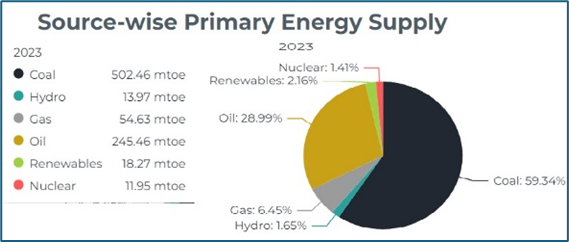Why in news?
As per energy experts, India is emerging as a critical player in the global energy transition, driven by its 7% GDP growth and rising power demand. They have noted that India is now the third-largest power market, with energy demand set to triple by 2050.
Despite expanding renewable energy, 70% of India's power still comes from coal, with 50 GW of coal and 10 GW of nuclear expected by 2030. In this context, they emphasized the need for increased electrification, energy storage, and grid infrastructure.
They emphasized India's growing role in the energy transition, with more solar and wind projects expected than coal plants by 2030. They also stressed the importance of battery energy storage systems (BESS) to manage renewable energy intermittency and grid stability.
They, further, pointed to India's growing lithium-ion battery production, with capacity expected to reach 150 gigawatt hours by 2030, covering 13% of global demand.
What’s in today’s article?
- India’s energy profile
- Issues
India’s energy profile
- Background
- India is experiencing rapid energy demand growth, but its overall energy consumption per person remains low compared to global averages.
- In 2023, India ranked third in primary energy consumption globally, at 39.02 exajoules (EJ), behind China (170.74 EJ) and the USA (94.28 EJ).
- However, India's per capita energy consumption was just 27.3 gigajoules (GJ), far below China’s 120 GJ and the US’s 277.3 GJ.
- India's per capita usage is comparable to Southern African countries (excluding South Africa) and much lower than the world average of 77 GJ.
- While India is steadily increasing its energy use, it is still far from reaching the consumption levels associated with high human development (around 100 GJ per person), which other large economies have already surpassed.
- Energy consumption
- Growth
- In 2023, India’s energy consumption grew by over 7.3 percent compared to 5.6 percent in 2022.
- The revival of economic activity following the end of the pandemic was among many drivers of growth in energy consumption in 2023.
- Fossil Fuel Consumption
- India’s Coal Consumption in 2023
- In 2023, India’s coal consumption for power generation reached 749 million tonnes (MT), surpassing the combined consumption of the US (280 MT) and Europe (286 MT).
- The increase mainly reflected a decline in coal consumption in the US and Europe, where coal is being replaced by cleaner alternatives.
- Coal use in the US fell by over 17%, and in Europe by over 16%, while India’s coal consumption grew by 9% due to industrial growth and increased household electricity use during a hot summer.
- Despite this, per capita coal consumption in the US was still over 50% higher than in India, and China's per capita consumption was four times higher.
- India’s Oil Consumption in 2023
- India's oil consumption stood at 5.18 million barrels per day in 2023, the fourth largest globally after the US, China, and Europe.
- The US's oil consumption was nearly equivalent to the combined totals of China and India.
- Per capita oil use in the US was more than 15 times higher than in India.
- India’s Natural Gas Consumption in 2023
- India's natural gas consumption in 2023 was 62.6 billion cubic meters (BCM), accounting for just 1.6% of global consumption. The US was the largest consumer (886.5 BCM), followed by Europe (463.4 BCM) and Russia (453.4 BCM).
- Non-Fossil Fuel Consumption
- In 2023, India saw a 15% decline in hydropower consumption due to reduced rainfall, following an 8.9% growth in 2022.
- However, India ranked fourth in global renewable energy consumption, behind China, the US, and Europe, which together accounted for nearly 60% of global renewables usage.
- India contributed 6.9% of global renewables consumption, with an impressive annual growth of 18.7% in 2023.
Issues
- India's Energy Profile vs. Global Energy Profile
- India's energy consumption differs significantly from the global average in coal and natural gas usage.
- Coal accounts for 59% of India’s commercial energy consumption, compared to 26% globally, while natural gas makes up around 6% of India’s energy mix, versus 26% globally.
- This divergence is due to India’s domestic coal availability, which ensures energy security and affordability.
- In other energy sources, India is more aligned with global averages.
- Overemphasis on Coal in the Global South
- The dominant global narrative often overemphasizes coal consumption in the Global South while downplaying oil and natural gas consumption in the Global North, even though all are carbon-emitting fossil fuels.
- This focus overlooks the underconsumption of energy in the Global South, which leads to more severe health and economic consequences.
- Energy Consumption: Global South vs. Global North
- The Global South, which accounts for 85% of the global population and 39% of global GDP, consumed over 389 exajoules (EJ) of energy, compared to the Global North’s 286 EJ.
- Given these disparities, it is time for the Global South, led by India, to reshape the global energy narrative to reflect its realities and challenges.










